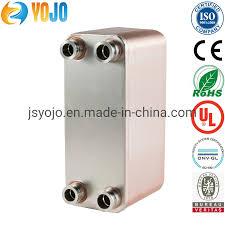In a world where energy efficiency and sustainability are becoming increasingly important, heat recovery technologies play a crucial role in minimizing energy waste and reducing carbon emissions. Fusion-bonded brazed plate heat exchangers are innovative and highly efficient heat transfer devices that are gaining popularity in various industries for their ability to recover and reuse waste heat effectively. In this article, we will explore the features, benefits, and applications of fusion-bonded brazed plate heat exchangers as a sustainable solution for heat recovery.
Introduction to Fusion-Bonded Brazed Plate Heat Exchangers
https://www.yojointernational.com/Fusion-Bonded-Brazed-Plate-Heat-Exchanger/Fusion-Bonded-Brazed-Plate-Heat-Exchanger.shtmlare compact and lightweight devices that are designed to transfer heat between two fluid streams efficiently. These heat exchangers consist of multiple stainless steel plates that are bonded together using a brazing process, creating a series of alternating channels for the hot and cold fluids to pass through. The brazing process ensures a strong and leak-proof construction, making fusion-bonded brazed plate heat exchangers suitable for high-pressure and high-temperature applications.

How Fusion-Bonded Brazed Plate Heat Exchangers Work
The operation of fusion-bonded brazed plate heat exchangers is based on the principles of heat transfer through conduction. When hot fluid enters one set of channels in the heat exchanger, it transfers its thermal energy to the adjacent cold fluid flowing through the other set of channels. The close proximity of the fluid channels and the large surface area of the plates facilitate efficient heat exchange, resulting in minimal energy loss and maximum thermal efficiency.

Benefits of Fusion-Bonded Brazed Plate Heat Exchangers
1.High Thermal Efficiency: Fusion-bonded brazed plate heat exchangers offer superior thermal performance compared to traditional heat exchanger designs. The compact plate arrangement and efficient heat transfer mechanisms ensure optimal heat recovery and minimal energy wastage.
2.Compact Design: The compact and lightweight design of fusion-bonded brazed plate heat exchangers makes them ideal for installations where space is limited. Their small footprint and modular construction allow for easy integration into existing systems.
3.Durability and Reliability: The brazing process used in the construction of fusion-bonded brazed plate heat exchangers results in a durable and leak-proof design. These heat exchangers are resistant to corrosion, erosion, and thermal stress, ensuring long-term reliability and performance.
4.Versatility: Fusion-bonded brazed plate heat exchangers are versatile devices that can be used in a wide range of applications, including HVAC systems, industrial processes, refrigeration systems, and renewable energy systems. They are capable of handling various fluid types and temperatures, making them a flexible solution for diverse heat recovery needs.
What Are The Applications of Fusion Brazed Plate Heat Exchangers?
1.Industrial Processes: Fusion-bonded brazed plate heat exchangers are commonly used in industrial applications to recover waste heat from manufacturing processes, chemical reactions, and power generation systems. By capturing and reusing waste heat, these heat exchangers help improve energy efficiency and reduce operating costs.
2.HVAC Systems: Fusion-bonded brazed plate heat exchangers play a vital role in heating, ventilation, and air conditioning (HVAC) systems by transferring heat between the air streams for efficient climate control. They are used in heat recovery ventilation units, heat pumps, and chillers to optimize energy usage and maintain indoor comfort.
3.Refrigeration Systems: Fusion-bonded brazed plate heat exchangers are used in refrigeration systems to recover heat from the cooling process and preheat incoming fluids. By utilizing waste heat for heating purposes, these heat exchangers help reduce energy consumption and greenhouse gas emissions in refrigeration applications.
4.Renewable Energy Systems: Fusion-bonded brazed plate heat exchangers are integrated into renewable energy systems, such as solar thermal and geothermal systems, to capture and store excess heat for later use. By harnessing renewable heat sources and maximizing energy recovery, these heat exchangers support sustainable energy practices and reduce reliance on fossil fuels.

Conclusion
Fusion-bonded brazed plate heat exchangers are a sustainable and efficient solution for heat recovery in various industries and applications. Their high thermal efficiency, compact design, durability, and versatility make them an ideal choice for minimizing energy waste, reducing operating costs, and lowering carbon footprints. By incorporating fusion-bonded brazed plate heat exchangers into heat recovery systems, businesses can enhance their sustainability efforts, improve energy management practices, and contribute to a greener future. Embracing innovative heat recovery technologies like fusion-bonded brazed plate heat exchangers is a step towards creating a more sustainable and eco-friendly environment for generations to come.
Understanding the Inner Workings of Fusion-Bonded Brazed Plate Heat Exchangers

